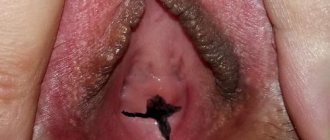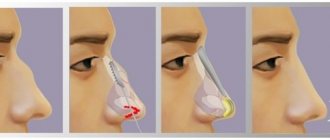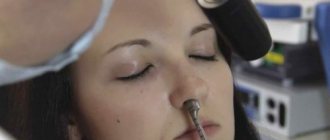Submucosal resection of the nasal septum is a surgical procedure to restore the correct anatomy of the nasal passages and physiological nasal breathing.
Author:
Galkin Alexey Vladimirovich
otorhinolaryngologist, rhinosurgeon
Added information about contraindications for submucosal resection.
Submucosal resection of the nasal septum is a surgical procedure to restore the correct anatomy of the nasal passages and physiological nasal breathing. It is prescribed in case of a deviated nasal septum, which provokes diseases of the ENT organs and also interferes with the aesthetics of the face.
What's happened
Endoscopic septoplasty is a gentle procedure to correct nasal septum defects. Moreover, if we compare this technique with similar manipulations, its advantage lies in its low cost.
The operation is performed using an endoscope. Thanks to such an instrument, the surgeon can control all the actions he performs, in particular, the movement of the cutting object and the formation of cartilage tissue.
The main feature of surgical intervention is that it is highly effective, does not take much time and does not require long-term rehabilitation.
This operation is prescribed when there is a pronounced increase in the nasal septum as a result of the growth of cartilage tissue, when the organ is deformed and nasal breathing is impaired.
How is rehabilitation after septoplasty?
With the development of technology, septoplasty has ceased to be uncomfortable. The operation begins with the patient being given anesthesia, then the doctor uses an endoscope, through a small incision, to enter between the layers of the mucous membrane and straighten the septum.
During the rehabilitation period, technologies were also created that allow the patient to avoid unpleasant sensations and breathe through the nose. Intranasal septal splints according to Reiter or splints were created. They are made of soft silicone, as it does not cause any harm to the nasal cavity and is painlessly removed from it. The splints have a seven-sided shape, which completely follows the shape of the nasal septum at the site of the operation. The essence of splints is that they keep the septum in the midline. After the operation, while the patient is under anesthesia, a silicone splint is sewn on.
Splints come in different modifications. Depending on the shape of the nose, they can be either large or small. A tube can also be inserted between the silicone of the splint, through which the patient can breathe immediately after the operation. The septal splint stays in the nose for about 5-7 days, during which time the nasal septum takes its position.
Indications
Endoscopic septoplasty is prescribed only in the presence of certain pathological conditions, which include:
- chronic congestion ;
- ARVI and acute respiratory infections;
- spines and ridges on the nasal septum;
- birth defects;
- snoring that accompanies throughout life;
- inflammation affecting the sinuses;
- swelling and dryness of the mucous membrane;
- allergic rhinitis
- development of sinusitis and sinusitis in a chronic form.
On this topic
- Septoplasty
Postoperative period after septoplasty
- Editorial board of Plasticology.ru
- August 7, 2020
It is also worth noting that the above indications must be accompanied by the growth of cartilage, which results in difficulty breathing.
It is in such situations that endoscopic surgery will be effective.
Types of septoplasty
The operation in question can be performed in two alternative ways. This is an endoscopic method, as well as a method involving the use of laser technology. It would be wise to look at each of them in more detail.
1. Endoscopic septoplasty of the nasal septum
Reviews report that this method is the most popular among patients. The operation in question does not leave any visible traces of surgical intervention, since all incisions are made exclusively on the nasal mucosa. As a rule, the integrity of the septum is preserved in full, except in cases where the cause of the curvature was physical injury (in such situations, some fragments of tissue must be removed). The operation itself takes from thirty to forty minutes. The entire complex of activities, including preparing the patient and administering anesthesia, lasts no more than one hour. Anesthesia used during surgery can be general, local or combined. Regardless of the choice, there will be no pain, judging by how endoscopic septoplasty is characterized by patients. Feedback from patients suggests that there is no need to be afraid of pain. After the procedure, there must be a short rehabilitation period.
2. Laser septoplasty of the nasal septum
Reviews often recommend this type of intervention as the least stressful for the patient. Obviously, in this case, a laser beam is used during the operation. During the operation, only local anesthesia is used. The whole procedure takes no more than half an hour. Its undeniable advantages over the previous type of treatment are its absolute non-traumatic and bloodless nature. Therefore, many people like laser septoplasty. The postoperative period (reviews place special emphasis on this) passes faster than usual and, what is extremely important, is absolutely painless. During rehabilitation, you do not have to stay in a hospital, or use turundas (tight tampons that are inserted into the nasal passages). However, not everyone can choose the method in question. This is due to the fact that the procedure has a number of contraindications. Also, the method is ineffective in situations where the curvature affects not only cartilage, but also other tissues.
Contraindications
Despite the popularity of this manipulation and good positive results, the technique has its certain limitations, among which are:
- bleeding disorders and other blood pathologies;
- liver failure , occurring in acute form;
- pathological processes of infectious or viral origin;
- HIV;
- oncological diseases;
- diabetes mellitus and other endocrine system disorders;
- tuberculosis;
- strokes and heart attacks;
- worsened chronic pathologies;
- old age of the patient.
In addition, surgery is contraindicated during pregnancy and breastfeeding.
Operation stages
Today there are several types of interventions. The first is a submucosal resection, and the second is more gentle. Rhinoplasty on the nasal septum is performed in the following way:
- The cartilage is cut. Some of it is removed.
- Bone tissue is removed using a small hammer and chisel, which is driven into the nasal cavity.
- The partition is fixed in the desired position. The tissues are brought together using cotton swabs.
In this case, no stitches are applied. This operation has been going on for a very long time. It is very traumatic and requires a long recovery time. After it is carried out, the face swells, and hematomas form under the eyes, which gradually resolve. In this case, you can remove the nasal hump. You can learn about endoscopic face lifting in this article.
The disadvantage of this type of intervention is the greater mobility of the septum due to the removal of a significant amount of tissue. Problems often arise with the mucous layer. The nose constantly feels dry. One of the advantages of this approach is the low price. However, dangerous consequences such as cartilage perforation may also occur.
Correction of the septum is also carried out in a less traumatic way. This includes septoplasty, which is performed endoscopically. In this case, a small incision is made in the nasal cavity exactly in the area of the curvature. An endoscope helps control the process. Only deformed areas are removed. The surgeon monitors the progress of the operation on a monitor. You can learn about removing warts with liquid nitrogen by following this link.
The video shows the operation to correct the nasal septum:
This type of intervention does not require a lengthy operation and has virtually no disadvantages. However, with significant curvature it is not used. Both types of intervention have almost the same principle and often complement each other. But in the second case, there is less impact on the cartilage and it is not removed in such quantities.
Currently, a new technique has emerged, based on the use of a special flattener, which is placed in the nasal cavity and helps the septum to take the correct position. In this case, the cartilage tissue is not removed. You can learn about check-lifting here.
Preparation
An operation to correct the nasal septum requires certain preparatory measures.
First of all, the patient should come to an appointment with the attending physician, who will examine the affected area, identify the severity of the problem and give a referral for a diagnostic examination.
A week before the expected date of correction, the patient must undergo a general urine and blood test, a blood test for sugar, coagulation, syphilis, hepatitis and HIV, group and Rh factor.
On this topic
- Septoplasty
Laser correction of nasal septum
- Editorial board of Plasticology.ru
- August 7, 2020
If surgery is prescribed for a woman, a pregnancy test must be done.
It is also necessary to do an electrocardiogram and fluorography.
If the examination results confirm the absence of contraindications and the presence of significant indications, the specialist will give recommendations on further preparation for surgery.
No later than 7 days in advance, you need to eliminate smoking and drinking alcohol from your life. Women will need to refrain from applying decorative cosmetics to their faces and performing any cosmetic procedures.
During the preparatory period, it is prohibited to eat food and take medications that have a negative effect on blood clotting. Citrus fruits, chocolate and other sweets should be excluded from the diet.
A light dinner is allowed the night before surgery. On the day of the procedure, you should not eat or drink, since it must be done on an empty stomach.
If the patient experiences psycho-emotional stress, a sedative can be taken.
Indications and contraindications
A deviated nasal septum leads, first of all, to a change in the breathing process. It becomes noisy and difficult. Chronic runny nose and even snoring often appear. This is especially dangerous in cases where the patient also suffers from high blood pressure.
When breathing becomes difficult, a person automatically switches to mouth breathing. In this case, more oxygen enters the body than it needs, and due to this, the pressure increases even more.
Also, difficulty in inhaling and exhaling leads to congestion in the nasal sinus. In the moist environment of the nasal cavity, all conditions are created for the proliferation of microorganisms, and this is expressed in inflammation. The patient may complain of constant colds even in the warm season, frequent sinusitis and otitis media, and even allergic rhinitis. Indications may also include frequent migraines, which cause nosebleeds.
On this topic
- Rhinoplasty
How to remove a hump on the nose
- Editorial board of Plasticology.ru
- July 8, 2020
Surgery to correct a deviated nasal septum is not performed in the following cases:
- Age less than 18 years - since the cartilage of the nasal septum can grow until adulthood.
- Poor clotting .
- Oncological diseases.
- Infectious diseases in the acute stage.
- Complex course of diabetes mellitus or other endocrine diseases.
- Exacerbation of chronic diseases of the cardiac or respiratory system.
Carrying out
To perform surgery, an endoscope is used, which is inserted inside through the nostrils. Thanks to this device, the doctor controls the entire course of the surgical process.
The operation is performed under general, or in some cases local, anesthesia. Depending on the complexity of the pathology, it takes 1-2 hours.
The operated area is treated with an antiseptic, after which a small incision is made inside the nasal cavity. Then, after exfoliation of the mucous membrane, the surgeon corrects all existing defects. As a rule, excess tissue is removed and a new position of the septum is formed.
After this, the operated areas are re-treated with an antiseptic solution and sutures are placed on the wound surface.
To fix the septum in its new position, special silicone tubes or tampons are inserted into the nostrils.
Upon completion of all actions, the patient is taken out of anesthesia.
Preparation for surgery and its characteristics
Rhinoplasty and other types of correction include a preparatory stage. In this case, a general analysis of blood and urine is performed. A biochemical study of blood clotting indicators is also necessary. A consultation with a therapist and an ECG are also considered important components of preparation that should not be neglected.
The operation is carried out only if a set of measures is observed. The main ones are:
- Discontinuation of medications containing components that can inhibit the rate of platelet aggregation. These include non-steroidal anti-inflammatory drugs and aspirin derivatives.
- The intervention is performed only by an ENT surgeon. In this case, general anesthesia is used. Sometimes rhinoplasty is performed under local anesthesia. It all depends on the degree of curvature.
- Access to the septum is only through the nasal cavity. The duration of the manipulations ranges from half an hour to 1.5 hours. In this case, all antiseptic rules must be observed.
The video shows the preparation of the operation to correct the nasal septum:
You will have to walk around with tampons in your nose for some time after surgery. This brings a lot of discomfort, but is a mandatory measure. A few days after the operation, the person is sent home. It is necessary to carry out some manipulations yourself to ensure antiseptics of the nasal cavity.
The operation involves varying degrees of intervention. In some cases, the swelling completely goes away only after a month, so breathing may be difficult for some time. For 4 weeks you cannot play sports or engage in other types of physical activity.
Recovery period
It does not take much time for complete healing after septoplasty. The patient remains in the hospital for a week and receives care at home for the next 14 days.
Since pain may be observed in the first days after surgery, the doctor recommends taking painkillers.
To reduce the severity of swelling, immediately after the procedure you need to apply a cold compress to the nose area.
It is necessary to undergo a course of antibiotic therapy, which will reduce the likelihood of infection.
Until the nasal cavity has completely healed, it is forbidden to blow your nose. If crusts form on the mucous membrane, saline solution or sea water is used to remove them.
To prevent bleeding in the first few days, do not take a hot bath or shower, or consume hot drinks or food.
In addition, for at least two weeks you need to avoid visiting the bathhouse, sauna, swimming pool, solarium and playing sports. It is prohibited to take medications that thin the blood. It is not recommended to wear glasses for one month so as not to injure your nose.
The bandage is changed and the sutures are treated daily.
Rehabilitation period
Tampons or silicone splints are placed in the patient's nose to fix the nasal septum in the desired position. The patient is forced to breathe through his mouth, which brings some discomfort. After 2-3 days they can be removed. After septoplasty, the nose is covered with a special plaster bandage from the outside. After the effects of anesthesia have subsided, the patient can return home. In the first few days, pain is felt, so the doctor prescribes analgesics. After 1.5 weeks, the pain disappears. Due to swelling of the operated nose, breathing is restored gradually. After 2–6 weeks, the patient's breathing returns to normal. Blood clots, mucus, and crusts will come out of the nose. To speed up the process, the patient must soak them with saline solution, as well as with the help of nasal agents based on sea water.
The full recovery time after septoplasty is about 4 weeks. For a month, you must refrain from physical activity, do not overheat or become hypothermic. It is not recommended to take alcohol or hot food for about 2 weeks. It is forbidden to bend forward for long periods of time, wear glasses, fly on an airplane, or sleep face down. You should also not take blood thinners. To avoid displacement of an unhealed septum, the nose should not be massaged, scratched, rubbed, and it is also prohibited to blow your nose.
Possible consequences and complications
After endoscopic septoplasty, in rare cases, various side effects may occur. The most common include the formation of hematomas as a result of excessive hemorrhage, the opening of bleeding, and inflammatory processes in the form of periochondritis.
Sometimes an abscess of the nasal septum occurs. This condition is considered the most severe; it occurs as a result of infection during surgery. To eliminate the problem, repeated surgery is prescribed.
Other complications include swelling, severe deformation, crusts in the nasal cavity, septal perforation and infection.
Complications
Septoplasty is a very simple operation, so the likelihood of complications after it is minimal. Typically, patients talk about bleeding and infectious diseases that develop against their background. To avoid this, be aware that some medications may increase the risk of bleeding. Therefore, before septoplasty, you need to consult with your doctor and let him know what medications you are currently taking or took shortly before going to the clinic. There are very rare cases of changes in the external shape of the nose or damage to the nerve endings after septoplasty. In order to protect yourself from this, it is important to contact only proven, highly qualified doctors who will not make such gross mistakes.
How long does the recovery process take?
Rehabilitation after septoplasty of the nasal septum takes an average of three months.
The duration of the rehabilitation period varies differently for all patients , which depends on adherence to treatment, compliance with medical recommendations and the characteristics of the body.
Conventionally, this period is divided into postoperative and immediate recovery.











